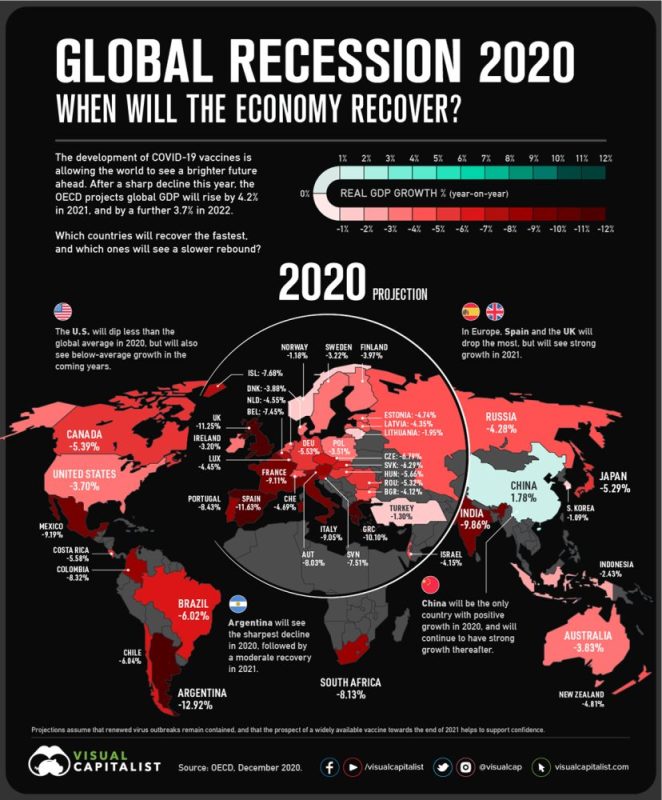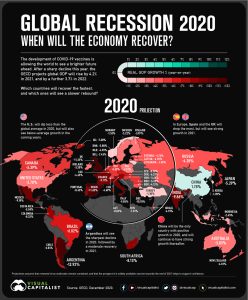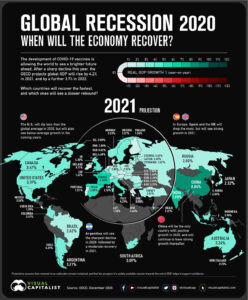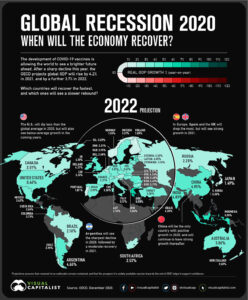Global recession 2020: when will the economy recover?
With 2020 nearly behind us, many are eagerly looking ahead to what 2021 will bring. COVID-19 vaccinations have begun, and hope is on the horizon for a stronger economy going forward.
The Organization for Economic Co-operation and Development (OECD) projects that after a 4.2% drop this year, the global economy will reach pre-pandemic levels in 2021. This animation, which uses data from the OECD, shows which countries will recover the fastest from the global recession in 2020.
Economic forecast by country
The projections assume that renewed virus outbreaks remain contained, and that a widely available vaccine near the end of 2021 helps to support confidence. Information used in the projections, such as monetary and fiscal policies, is as of November 27, 2020.
Here is how the economic forecasts break down for both OECD and non-OECD countries, sorted by projected real GDP growth in 2021:
| Country | 2020P | 2021P | 2022P |
|---|---|---|---|
| China | 1.78 | 8.04 | 4.95 |
| India | -9.86 | 7.90 | 4.83 |
| France | -9.11 | 6.03 | 3.27 |
| Spain | -11.63 | 5.00 | 3.99 |
| Belgium | -7.45 | 4.69 | 2.68 |
| Italy | -9.05 | 4.29 | 3.17 |
| Chile | -6.04 | 4.25 | 2.96 |
| United Kingdom | -11.25 | 4.20 | 4.10 |
| Indonesia | -2.43 | 3.96 | 5.05 |
| Argentina | -12.92 | 3.71 | 4.55 |
China started recovering earlier than most countries, and is projected to be the only country with positive GDP growth in 2020. Strong growth will continue in 2021, when China will account for over one-third of global economic growth.
Meanwhile, India experienced one of the world’s tightest lockdowns and will see a large GDP drop in 2020. The decline has exacerbated inequality, as school closures disrupt meal programmes and prompt dropouts by disadvantaged children. While the economy is forecast to grow from 2021-2022, it may take almost two years for GDP to fully recover.
Out of the countries measured in OECD’s forecast, Argentina will see the biggest GDP decline in 2021. Rising unemployment and inflationary pressures have contributed to the decline.
New Zealand’s GDP loss was similar to the OECD average, despite a larger drop in mobility, from the last quarter of 2019 to the second quarter of 2020. A recovery will partially depend on travel restrictions, as tourism accounted for 20% of the country’s total employment in 2019.
A fragile recovery
Considerable uncertainty about near-term GDP projections remain—$7 trillion of uncertainty, to be exact.

A downside scenario would be caused by delayed vaccinations or new outbreaks, and would lead to a $4 trillion GDP loss by 2022 compared to current projections. An upside scenario, spurred by fast vaccine rollout and boosted consumer and business confidence, could add $3 trillion to the global economy.
However, it is likely that the pandemic has caused permanent losses no matter the scenario.
As we wait for vaccines to be widely available, the OECD recommends that governments implement clear COVID-19 containment measures. While debt-to-GDP ratios have risen substantially due to stimulus packages, the organization also recommends that governments maintain strong fiscal support.
In particular, policies should be directed towards the most vulnerable, such as low-skilled workers, small businesses, and children. This may foster a more even recovery from the global recession of 2020.








